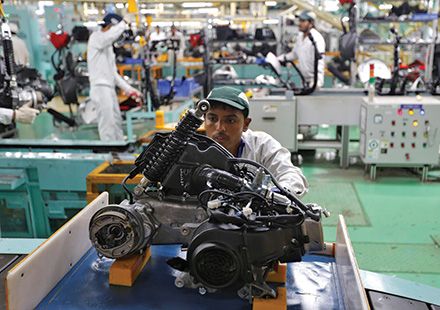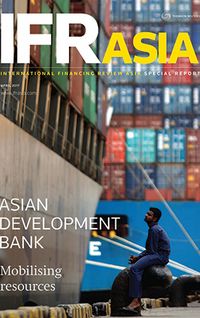A weak banking sector and a hangover of failed infrastructure projects have challenged Narendra Modi’s bid to revive capital expenditure, but there are signs that the capital markets are helping revive the investment cycle.
India, at least by one metric, is the brightest spot in Asia. Its stock market is up 10.2% since the start of the year, as of April 19, edging past the Philippines as the region’s best performer of 2017.
The BSE Sensex index closed at a record 29,974.24 on April 5, a 16% gain since late December. The rupee, too, has outperformed, strengthening through 64.5 to the dollar in April for the first time since August 2015.
That is all the more impressive in a country that took 86% of its currency out of circulation in November, triggering a cash crunch while savers and business owners struggled to get hold of new high-denomination banknotes. Government estimates point to slower GDP growth of 7.1% in the year to March 31, down from 7.9% in the previous fiscal year.
Equity valuations point to a bright future, but investment is still holding back growth. Stalled projects and rising bad debts have sapped appetite for expansion, dragging credit growth down to 8.0% in the last fiscal year, its lowest in over a decade, according to the ADB’s Asian Development Outlook report.
The government is looking at ways to restart the investment cycle.
“Investment is a challenge,” said Arvind Subramanian, the government’s chief economic adviser, at a Credit Suisse conference in Hong Kong in March. India, he says, is wrestling with a “twin balance sheet problem”, where corporate borrowers are overindebted and banks, especially in the public sector, are constrained.
“The combination of these two means that investor sentiment remains weak. The ability to invest remains weak. The ability to supply credit and finance remains weak. This is going to be the number one challenge for the government.”
Stalled projects and bad debts are hardly new features in India, but Subramanian says the government is redoubling its efforts to break the deadlock.
“A lot of time and energy is being devoted to this. It’s a very hard and intractable problem and we’re trying to find ways to move forward.”
Joseph Zveglich, director of macroeconomic research at the ADB, believes reforms and foreign investment can restart the cycle.
“We’ve been saying for a few years now that it would be a reform-driven pickup in growth, and they are delivering on this,” he said, pointing to the introduction of a goods and services tax from July as evidence that Narendra Modi’s government is able to push through difficult pieces of legislation. The ADB forecasts a slight acceleration in GDP growth to 7.4% in fiscal 2017, rising to 7.6% in 2018.
“Some of this will be to what extent India can make the reforms to bring in foreign investment which might help to pick up other activity,” he said. “That’s where some of these reforms become even more critical. If you do have a kind of stalemate then you need to bring in something from outside to break it up.”
Foreign direct investment offers further reason for optimism. Official data points to FDI inflows of US$35.8bn in the nine months to December 2016, up 22% on the same period a year earlier. Subramanian has touted inflows running at US$60bn a year as evidence of international confidence in the Indian economy, though he acknowledges that India can do more to attract overseas investment in the manufacturing sector.
“On balance we would probably like more to come into manufacturing, and that is why I think the Make in India programme is very important, but it’s still predominantly in services,” he said.
“Some rejigging to get manufacturing to be more dynamic will naturally alter the composition of FDI as well. But US$60bn, US$70bn, even US$100bn of FDI – regardless of where it goes to – is wonderful news.”
Capital markets
Booming equity markets offer another way to address India’s twin balance sheet problem, and there are signs that the government is making the most of rising valuations to monetise its stakes in a variety of state-owned enterprises.
Finance Minister Arun Jaitley has set a Rs725bn (US$10.76bn) target for divestment in the 12 months from April 1, up from a revised Rs455bn goal in the current fiscal year.
The government intends to raise Rs110bn from the listing of state-owned insurance companies, Rs465bn from the sale of stakes in state-owned companies on local stock exchanges and Rs150bn from strategic sales in 2017–18.
It is wasting no time on the floats. At the time of writing, banks were bidding for underwriting roles on IPOs of state-owned reinsurer General Insurance Corporation of India, New India Assurance and five state businesses in the rail sector – Indian Railway Finance, Indian Railway Catering and Tourism, Ircon International, Rail Vikas Nigam and Rites.
The Department of Investment and Public Asset Management has also invited banks to pitch for share sales in seven state-owned companies – NTPC, Indian Oil Corp, Steel Authority of India, Rural Electrification Corp, Power Finance Corp, NHPC and NLC India. Together the stakes are worth up to Rs345bn (US$5.3bn), though some bankers doubt that India will complete all the disposals in the current financial year.
The acceleration of public sector capital raisings has not yet translated to the country’s banks or the private sector, despite reforms that have opened up new sources of equity financing.
India is still waiting for the first trust listing, having introduced rules to allow real estate investment trusts and infrastructure investment trusts, known as InvITs, as long ago as 2014. Tax issues were clarified in 2016 and restrictions on potential investors lifted earlier this year, raising hopes that the first deals will finally come to market.
Infrastructure owners IRB, IL&FS, India Grid and Reliance Infrastructure have announced plans for InvITs, while local developers Embassy, K Raheja Group, DLF and RMZ Group have hinted at REIT listings.
Now that the shock of last year’s demonetisation has subsided, the additional liquidity in the banking sector may also spur credit growth and allow companies to resume their investment plans. The government has also revamped bankruptcy legislation to help banks work through their stock of bad debts in a quicker and more orderly process, but Subramanian concedes that progress will take time.
“Money is the least of the problems,” he said. “Coming up with money to recap the banks in some sense is not a big deal. Even if we only recovered 40% of a very generous estimate of bad loans, the fiscal cost would be something like 2.5%–3% of GDP.”
“It’s more the political ability for the system to write off these loans. That is very tricky.”
To view all special report articles please click here and to see the digital version of this report please click here.
To purchase printed copies or a PDF of this report, please email gloria.balbastro@thomsonreuters.com.



